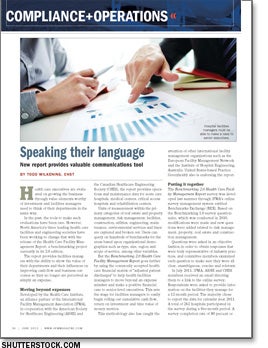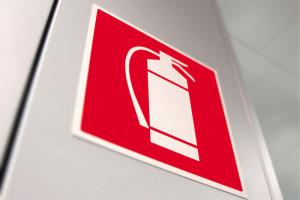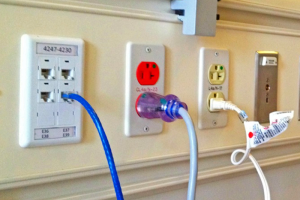Speaking their language

Health care executives are evaluated on growing the business through value elements worthy of investment and facilities managers need to think of their departments in the same way.
In the past, the tools to make such evaluations have been rare. However, North America's three leading health care facilities and engineering societies have been working to change that with the release of the Health Care Facility Management Report, a benchmarking project currently in its 2.0 edition.
The report provides facilities managers with the ability to show the value of their departments and their influences on improving cash flow and business outcomes so they no longer are perceived as simply an expense.
Moving beyond expenses
Developed by the Health Care Institute, an alliance partner of the International Facility Management Association (IFMA), in cooperation with the American Society for Healthcare Engineering (ASHE) and the Canadian Healthcare Engineering Society (CHES), the report provides operations and maintenance data for acute care hospitals, medical centers, critical access hospitals and rehabilitation centers.
Units of measurement within the primary categories of real estate and property management, risk management, facilities, construction, utilities, engineering, maintenance, environmental services and linen are captured and broken out. Users can query on hundreds of benchmarks for the areas based upon organizational demographics such as type, size, region and scope of service, among other variables.
But the Benchmarking 2.0 Health Care Facility Management Report goes further by using the commonly accepted health care financial matrix of "adjusted patient discharges" to help health facilities managers to move beyond an expense mindset and make a positive financial case to senior-level executives. This sets the stage for facilities managers to easily begin rolling out cumulative cash flow, return on investment and time value of money metrics.
This methodology also has caught the attention of other international facility management organizations such as the European Facility Management Network and the Institute of Hospital Engineering, Australia. United States-based Practice Greenhealth also is endorsing the report.
Putting it together
The Benchmarking 2.0 Health Care Facility Management Report survey was developed last summer through IFMA's online survey management system entitled Benchmarks Exchange (BEX). Based on the Benchmarking 1.0 survey questionnaire, which was conducted in 2010, modifications were made and new questions were added related to risk management, property, real estate and construction management.
Questions were asked in an objective fashion in order to obtain responses that were truly representative of industry practices, and committee members examined each question to make sure they were all clear, unambiguous, concise and relevant.
In July 2011, IFMA, ASHE and CHES members received an email directing them to a link to the online survey. Respondents were asked to provide information on the facilities they manage for a 12-month period. The majority chose to report the data for calendar year 2011. A total of 262 hospitals participated in the survey during a five-month period. A survey completion rate of 80 percent or above was considered usable, yielding 184 surveys for analysis.
To ensure high-quality data, highly structured coding and data verification procedures were used. In addition, all variables and values were checked to verify that they were within appropriate ranges, and inappropriate outliers were corrected or removed. A full statistical analysis followed, using a professional software package. Standardized data analysis procedures included reviewing descriptive frequency counts and cross tabulations of responses for variables of interest.
To maintain the real-world usability of these findings, statistics most often are provided in terms of absolute number of responses, percentages and mean averages. Percentages may not total 100 percent due to rounding or the acceptance of multiple responses. In many cases, some respondents did not answer all questions, so the base numbers differ among the findings.
Additional calculations were made to determine cost and utility consumption per square foot, square footage per full-time equivalent employee (FTE) and cost per discharge. Utility consumption data were changed to match the unit specified. Canadian cost data were converted to U.S. currency and metric numbers were converted to standard.
Handy toolbox
The Benchmarking 2.0 report can be viewed as a handy toolbox to help facilities managers show the results that are important to senior-level executives. Data are at their fingertips to learn the true cost based on square feet and adjusted patient discharge.
When it comes to overall utility consumption per gross square foot (GSF), for instance, electricity sharply remains a key contributor. The high consumption multiplied by the high cost will help facilities managers as they try to encourage their senior executives to invest in energy conservation strategies.
Based upon the survey results for cost per GSF, the mean for the total cost of utilities is $3.23 per GSF, with electricity accounting for 71 percent. With natural gas accounting only for 25 percent of the total cost of utilities, it is no wonder emphasis on reducing electrical use takes center stage.
Consumption per patient discharge is startling compared with what is consumed in residential settings. The average number of kilowatt hours (kWh) per patient discharge is 1,829.04. Thus, each patient discharge is equal to more than two months of electricity in a home based upon the average number of kWh used per day (30.16 kWh) as provided by the U.S. Energy Information Association.
Declining hospital use and length of stay have been attributed to cost-containment measures instituted by the Medicare and Medicaid programs. This places more emphasis on the need to maximize cash flow when patients are visiting the hospital. The average total utility cost shows a mean of $230.49 per patient discharge. As with cost per square foot, this is 71 percent of the total utilities.
This makes the case that when business volumes are down, energy conservation becomes increasingly important. Here is where the facilities manager can really improve the bottom line and be able to prove it to the CEO.
For example, a facilities manager can sell an energy cost-containment strategy to the C-suite as the path to improving cash flow. The facilities manager can state that the facilities department desires to reduce utility costs by 10 percent or 32 cents per square foot. But, a better way to frame it is, "We will improve our organizations finances through reducing utility consumption by 10 percent in order to improve cash flow by $23.05 for each patient served."
With regard to total maintenance expenses, the average mean was $5.04 per gross square foot with 45 percent being spent on interior systems. As hospitals continue to retain their competitive advantage through more elaborate patient care environments, it will be interesting to see if the number of dollars spent on interior systems grows.
On a cost per patient discharge, only an average of 35 percent is being spent on interior systems. Benchmarking 2.0 also provides even more detail about where hospitals are spending their dollars and identifies what maintenance positions are the most important to invest in today.
This is where health facilities managers close the communication gap with senior executives as the adjusted patient discharge is one of their key financial indicators. Business analytics is the buzz phrase in health care today and the savvy facilities manager must embrace and master it from the top down.
Targeting the Triple Aim
The result of this improved financial acumen ultimately will help the facilities manager play an active role in the movement toward accountable care organizations (ACOs) or ACO-like enterprises.
The Accountable Care Act has developed the Triple Aim approach to ACOs that call for them to improve the health of the population served, improve the experience of each individual patient and improve affordability as measured by the total cost of care.
Facilities managers hold in their hands many influences that are targeted by the Triple Aim. These include aesthetically pleasing environments, reliability, sustainable practices and maximizing the life cycle of buildings and equipment, to name a few. Not scoring well with the Triple Aim can mean lower governmental reimbursement and a black eye in the community.
Health care organizations must provide measurable data to maximize reimbursement. Facilities managers need to demonstrate how they measure up. This is the key advantage of the benchmarking report, which allows health facilities managers to drill down into literally hundreds of benchmarks.
In general, health facilities managers will have access to key benchmarking matrices to compare similar organizations in terms of square footage and patient volumes, including usage and costs, and best practices used by others. This data can be used to lower operating expenses and offer the ability to provide high-quality, measurable outcomes and deliver reports tailored to senior executives and facilities managers simultaneously.
Benchmarking leads to questions of confirmation and opportunity to further the business of health care. Through the Benchmarking 2.0 report, a facilities manager can increase his or her net worth as a business partner in common terms that senior executives and the facilities manager will understand.
Communicating effectively
Senior executives don't have time to master the same level of operational knowledge as do facilities managers. They are preoccupied with budgetary pressures and analyzing competitive forces.
What executives in the C-suite need to hear is that the money they spend will come back as increased revenue and profits in support of the triple bottom line.
To communicate effectively, health facilities managers must speak differently to senior executives than they normally do. They must make it easy for executives to understand their needs in a language they use every day.
Todd Wilkening, CHST, is director of facilities at Ridgeview Medical Center in Waconia, Minn., and also serves as chairman of the International Facilities Management Association Health Care Institute's Benchmarking 2.0 Committee. He can be contacted at todd.wilkening@ridgeviewmedical.org.
| Sidebar - Get a copy of the 2.0 report |
| The Benchmarking 2.0 Health Care Facility Management Report results are free to participating health care organizations and available to others for a nominal fee. In addition to online access to the results, participants will be sent a copy of the Benchmarking 2.0 Report compliments of the International Facility Management Association (IFMA), American Society for Healthcare Engineering (ASHE) and the Canadian Healthcare Engineering Society (CHES). Nonparticipants without a membership to IFMA, ASHE or CHES can purchase a PDF of the report for $160, an interactive online version for $150 and both for $260 at healthcarefacilities.gallup.com. Members of IFMA, ASHE or CHES who did not participate in the survey also will receive a special invitation by their organizations to include a discount code for their respected members. |
| Sidebar - Benchmarking 3.0 report is coming |
| The next edition of the Health Care Facility Management Report is already in the planning stages and facilities managers will have an opportunity to participate in the 3.0 report in October. With this report, facilities managers will have even more benchmarks that will aid them in the business of health facilities management. The feasibility of pushing the survey beyond North America is also being explored. One highlight of 3.0 will be demonstrating how facilities managers can turn comparable benchmarks into real-time dashboards to guide them through their day-to-day decisions, maximizing resources with unprecedented efficiencies in a measurable way. This will leave the C-suite with no doubt about the value facilities managers bring to their organizations. For more information, go to healthcarefacilities.gallup.com. |




